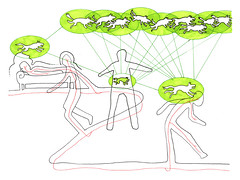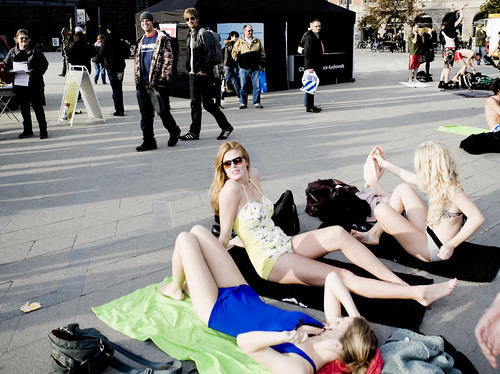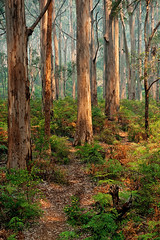Often when a telemarketer rings my house, just around dinner time, I know what to expect. I also know that by revealing that I work in marketing that I will be disqualified from the survey. But for those of you who like to push the envelope, you may want to print out and keep a copy of this neat telemarketer counter script by your phone. Then, you can put a little chaos of your own into action. Enjoy!
Month: November 2009
Climate Change? It’s Child’s Play
I have always been interested in action. If I see a problem, my mind automatically switches to potential solutions. I immediately begin to think through the steps needed to identify a way forward – how to position and frame the challenge, who to involve and how to build momentum. But maybe I am overthinking climate change – and the case for hope and need for action.
Perhaps the solutions to climate change are far more simple than we think. Dylan seems to agree.
Via Brand Republhttp://www.brandrepublic.com/Discipline/Digital/News/969735/Baby-Creative-seeks-simplify-climate-change-issues-YouTube-film/ic.
Re-intermediating the Media
 One of the things that most excited me about the World Wide Web was the way it crushed the distance between an idea and its reality.
One of the things that most excited me about the World Wide Web was the way it crushed the distance between an idea and its reality.
The mere fact that I could, with a few spare hours and a scrapper’s knowledge of HTML, create a website – a “place” on the internet where nothing was before – seemed to me, a revelation.
Over the last 20 years we have seen a dramatic transformation in the media landscape. The promise of the early web has been delivered. Now, you or I can produce web pages and whole sites without the need of complex programming or large scale resources. We can produce “media” or what largely passes for media, using a $50 webcam, a microphone borrowed in the downtime between Singstar sessions, and a point of view all held together with a dash of passion.
The easy availability of technology and the digital publishing platforms sent waves of transformation through all forms of publishing – from books, magazines and newspapers to radio, TV and beyond. The full effect of this slow moving tsunami is yet to be seen or accounted for – but the lasting transformation is in the nature of power.
In the wake of these changes, the power that was once centralised in the hands of the publishers and broadcasters has been fragmented – tossed like so many pins into a new global haystack of content, opinion and conjecture. As Ben Shepherd points out, the winner here has been the search engines and content organisers like Google:
Google came in and created a tool that allowed internet users to find what they needed quickly and easily. It reinvented search and has allowed consumers to get anything they want, whenever they want, and for the price they want – generally for free.
But we are now experiencing another wave of transformation. Where the first wave shifted the base of power away from the broadcasters towards the content organisers, this next wave of disintermediation is moving information – and recommendation – away from the search engines. As a result we are seeing people powered networks (best characterised by sites like Twitter and Facebook) benefitting from this new shift in the locus of power. Tom Ewing describes it simply:
This shift is best interested, I think, in thinking about the difference between corporate brands and ‘personal brands’. The corporate brand entering social media is urged to give up control, to surrender some of its autonomy. But Twitter’s most popular users – its A-Listers, the celebrities – are using it to regain a level of control over their presentation and perception, through disintermediation.
This trend, while still small, will have Google worried, for while they seem to struggle with the human dimension of the social web, they certainly understand the power principles inherent in social network design and its resulting viral expansion loop. Interestingly, however, most social media participants, once they reach a certain scale, invest in the creation of what can best be termed “old-school media properties” – turning what little influence they do hold into a business modelled around advertising, sponsorship and editorial.
This seems to be a zero sum game to me – properties built on new foundations seem to sit uncomfortably within business models that they themselves, helped discredit. But what has been missing is a way to re-intermediate the new media – bridging the gap between business, brands, advertising, media buying and planning, and these long tail publishers. In the last few weeks two new players have stepped into this space. MediaScope, the brainchild of Denise Shrivell is “an online directory connecting advertisers, marketers and small business to 'alternative' media opportunities in niche, below the line, emerging and independant platforms.” It is due to launch in the coming days.
Media Cafe is also staking a claim in this space – but bringing perhaps a fuller community based publishing model to market. Currently in pre-release mode, Media Cafe is also open for the population of data ahead of a launch. Interestingly, Media Cafe appears to be putting new social properties on the same footing as traditional media properties. This aspect alone is likely to raise eyebrows, but will it unleash a new wave of innovation and transformation. No doubt both MediaScope and Media Cafe are banking on it.
Five Must-Read Posts from Last Week
 Over the last week there has been plenty of discussion around the concept of intellectual property – who owns it and who gets paid for it. Is intellectual property the pursuit of businesses or individuals – and how do we (as brands, marketers, innovators, consumers) tap into this? Do we consider this work or is it just part of the fabric of life? These five must-read posts seek to answer some of these questions! Enjoy:
Over the last week there has been plenty of discussion around the concept of intellectual property – who owns it and who gets paid for it. Is intellectual property the pursuit of businesses or individuals – and how do we (as brands, marketers, innovators, consumers) tap into this? Do we consider this work or is it just part of the fabric of life? These five must-read posts seek to answer some of these questions! Enjoy:
- Katie Chatfield loves “free” but argues that we need to also reward the creators, the innovators and the artists. Couldn’t agree more.
- Gareth Kay is working a similar theme – showing how artist revenues are increasing in this era of “file sharing”. Seems the real value lies in the story telling and re-telling.
- Ever wondered what makes a story come to life? For me, it is in the telling and retelling. That’s where passion comes in. John Hagel digs into the nature of passion and how it manifests. Gold.
- What does passion have to do with our work? Luc Debaisieux shares a presentation on the Future of Work.
- And if you have a couple of spare minutes to watch a video, Joseph Jaffe suggests that it’s better to give than receive.
The Case for Hope and the Need for Action
 In a little over two weeks, the world’s leaders will be meeting in Copenhagen to discuss and hopefully agree on decisions to reduce carbon emissions. The United Nations Climate Change Conference (COP15) is perhaps the last chance to achieve consensus on this contentious issue.
In a little over two weeks, the world’s leaders will be meeting in Copenhagen to discuss and hopefully agree on decisions to reduce carbon emissions. The United Nations Climate Change Conference (COP15) is perhaps the last chance to achieve consensus on this contentious issue.
Why should you care?
According to the Intergovernmental Panel on Climate Change, the carbon emissions for all countries must (not will) peak no later than 2015. These emissions then must reduce by 80% or more by 2050 if we are to avoid the worst effects of climate change.
Sounds bad, right? Sounds difficult, yes?
The thing is, we are being asked to make decisions – or rather – we are asking/pushing our leaders to make decisions on our behalf. But these decisions won’t just change our lives – they will have far reaching impacts on our children and grandchildren. How important are your children to you? What kind of world do you want to see them live in?
 I don’t know about you, but one of the most joyous memories I have from childhood is running through a sprinkler with my brother on the hot days of summer. These simple, common activities bond us as families and communities – they signify where you grew up – where you belong. And I have a feeling that losing these things will profoundly affect the way that we see ourselves as a society.
I don’t know about you, but one of the most joyous memories I have from childhood is running through a sprinkler with my brother on the hot days of summer. These simple, common activities bond us as families and communities – they signify where you grew up – where you belong. And I have a feeling that losing these things will profoundly affect the way that we see ourselves as a society.
Already, the world I live in looks vastly different to the one I grew up in – and the opportunities and experiences I had may simply not be available to future generations.
Is this a big deal for business?
One of the biggest challenges for business is not necessarily the costs involved with climate change – it is the uncertainty. As James Farrar points out, “Most business leaders already understand that CO2 emissions are a significant risk to the sustainability of their business but they lack the regulatory certainty and incentives necessary to begin to deal with the problem.” Once these frameworks and incentives are in place, business leaders will be able to focus on the programs of change, innovation and investment that will put them at the forefront of their industries.
What? You're a climate change skeptic?
I am not asking you to change your beliefs. I know all the facts in the world won’t change your position. I am just asking you what are you prepared to risk? What is the risk of inaction?
What can you do?
You can start by registering your petition with the Hopenhagen website – calling on global leaders to “seal the deal”. There are Facebook applications, blog posts, T-shirts and so on – all available from the Hopenhagen website.
Of course, there is more. There is always more that we can do. The important thing is to start.
The Communication Ideal
 I think I can just give up now and read/re-read Jonathan MacDonald’s excellent Communication Ideal:
I think I can just give up now and read/re-read Jonathan MacDonald’s excellent Communication Ideal:
The Communication Ideal would ensure that Advertising and Marketing communication is more positive, engaging and beneficial to every single one of us.
You can read the eBook version for free or purchase a paperback version here.
Via Patrick Searle.
Seeing the Trees in the Social Media Forest
 With each passing day there are more and more case studies, examples and justifications for brands to use social media. There are best practices emerging (or easily found with a Google search), thousands of “how to” blog posts explaining every aspect of social media (or perhaps the same aspect repeated 1000 times) and agencies devoted to social media as their core competency.
With each passing day there are more and more case studies, examples and justifications for brands to use social media. There are best practices emerging (or easily found with a Google search), thousands of “how to” blog posts explaining every aspect of social media (or perhaps the same aspect repeated 1000 times) and agencies devoted to social media as their core competency.
But it seems to me that we are beginning to swim (or is it drown?) in data. Because our social media interactions are digital, we can measure plenty of things – the time you spend on our sites, the things you click on, where you have come from, where you are going to, how much you spend, what you liked, rated and searched for and so on. And if you happen to have created a social network profile then we know even more about you – age, work history, relationships, preferences for products, brands, music, movies and so on.
But I have to ask – in amongst all this data, are we missing the trees for the forest?
You see, as marketers and as business people, we have been conditioned to think about after-the-fact aggregated data. We are used to thinking about what people DID based on certain conditions. This then allows us to cut-and-dice, segment and fine tune our customer base. It allows us to build out personas that make sense within the context of OUR BUSINESSES.
This works fine in a model where the direction of business communication is one way. It’s perfect in a world of broadcast – for in a broadcast world we are only interested in the forests (there being far too many trees to deal with). However, in a world where communication is polyphonic – where the authority of the message depends less on how shrill you are or how much air time you can buy – and relies instead on the trusted flow of recommendations from individual to individual, then a strategy which allows you to distinguish a hardwood from plantation pine is essential.
What this requires is for us to stop thinking about ROI.
It means turning our attention away from the R – the returns that come to us or our businesses – focusing instead on the I – what it is we are investing in.
By understanding who our consumers are, what our brand advocates look like, what they do (apart from loving our brands – yeah right!), where they play and so on, we can identify opportunities to engage with them. We need to invest in the RIGHT relationships – those that lead towards returns (monetary and non-monetary). We need to remember that branding is a marathon – that it all takes time – but we also need to work smarter. We need to take our excellent marketing processes and understanding and apply it in a way that enhances the way that we view our audiences. We need to use our knowledge of the forests to make sense of the trees, and only then will we begin to realise not only that social media makes sense for our businesses, but that “social” is the business.
Five Must-Read Posts from Last Week
 In the last week there have been a plethora of posts looking at short term futures – what’s ahead of us, what it takes to get there and even some suggestions of how real change takes place.
In the last week there have been a plethora of posts looking at short term futures – what’s ahead of us, what it takes to get there and even some suggestions of how real change takes place.
There’s Plenty to read for marketers on the client and/or agency side.
- In this Ad Age article, Jacques-Herve Roubert suggests that Digital Agencies are Ready to Lead when it comes to engaging clients, creating campaigns and building their clients brands.
- Neil Perkin explains that it could just be social media that saves mainstream TV. In The Socialisation of TV, Neil suggests that scheduling and viewing are coming together via social back channels – but wonders whether on-demand viewing will shift the way this works (and where the power lies).
- Mitch Anthony has a great post uncovering the logic of deep change – digging into the work of John Hagel, Lang Davison and John Seely Brown. I am a big fan of the thinking behind the Big Shift – as well as the concept that the edge transforms the core. It’s like where philosophy and marketing meet – what’s not to love?
- In amongst all the noise that comes with marketing, advertising and social media, sometimes – as an industry – we go beyond the talk to do something that is really worthwhile. Tim Burrowes points to some excellent recent efforts to have emerged in recent weeks. I would like to also add that in the last week, The Wayside Chapel has been saved from its funding and building crisis. Great stuff.
- While this was not published last week, it is the first time that I have come across Jack Cheng’s blog – and wanted to make sure I shared it with you all. Some great, deep thinking here – as well as practical advice. Just take a look at what you can learn in 30 minutes a day. Dig deep.
Can Curating the Crowd Work?
 Having worked on two, and heading into the third Age of Conversation book (bringing together hundreds of thought leaders in a single, crowdsourced book), not to mention our recent efforts around The Perfect Gift for a Man (30 crowdsourced stories reinventing manhood), I feel like I have a fairly good grasp on crowdsourcing and its potential.
Having worked on two, and heading into the third Age of Conversation book (bringing together hundreds of thought leaders in a single, crowdsourced book), not to mention our recent efforts around The Perfect Gift for a Man (30 crowdsourced stories reinventing manhood), I feel like I have a fairly good grasp on crowdsourcing and its potential.
But can it work for advertising? Will it work for agencies? And, perhaps, most importantly, will it work for the communities which emerge almost spontaneously to become part of a crowdsourcing project?
Unilever are putting this to the test. Via Idea Bounty, the Peperami brand are tapping the wisdom (and creativity) of the crowd to ideate their next integrated marketing campaign. Those creating the winning idea will receive a $10,000 payment and see their concept be turned into a global campaign.
But this is not a one-off – The Guardian reports, “Unilever said it has no plans to retain a full-time ad agency for the Peperami account in future.” So clearly, we are seeing the beginning of a shift – the Brand (Peperami) are moving ideation away from the agency world and reaching out directly to their customers. In response, over 1000 submissions were received.
Amelia Torode airs her concerns around crowdsourcing advertising – and the energy with which it has been taken up – raising some interesting points in the process. For example:
- Is the $10,000 prize a rip-off? After all Unilever is one of the world’s largest consumer companies
- Turning ideas into something more substantial takes real skill, expertise and commitment
- Have agencies been “over-paid, over-precious, over-protective”
The comments to the post make for great reading. The debate moves from the role of creatives and interns (and whether they are ripped off by the agency business) to the process followed by Idea Bounty.
But the question that concerns me is – “is this sustainable?” Crowdsourcing is hard work. Not all ideas have legs – or can be extended across different channels and cultures. There is a real overhead – which I presume will be taken up by Idea Bounty – and it may simply be that we shift the budget from the ideation stage to the curation of those ideas. And if that is the case, have we really achieved anything? Will the ideas be better? Will the sales increase? Will the brand be more loved by its consumers?
There are many more questions … but I will leave you with this – if your customers really do become the creator of your brand, and if they are successful, do you share the spoils of the success with your community? You see, for me, crowdsourcing is not one way – and while a one-off “prize” may satisfy at first, it could easily leave a bad taste in the mouth long after the first bite. And is ANY brand ready for the kind of backlash this could generate? Are you?
One Wish – The Charter for Compassion
 If you had a wish, what would it be? Would you direct it inwardly or towards others? Would it be personal or would it be communal? Would it be larger? Would your wish be transformative, transactional or fanciful? Could you name it, nail it down, write it on a sign? Is it something you could share or would it remain a personal secret? Would you wear your wish upon your sleeve or swallow it like a burning truth?
If you had a wish, what would it be? Would you direct it inwardly or towards others? Would it be personal or would it be communal? Would it be larger? Would your wish be transformative, transactional or fanciful? Could you name it, nail it down, write it on a sign? Is it something you could share or would it remain a personal secret? Would you wear your wish upon your sleeve or swallow it like a burning truth?
Karen Armstrong has a wish. The TED Prize winner’s wish is as follows:
I wish that you would help with the creation, launch and propagation of a Charter for Compassion, crafted by a group of leading inspirational thinkers from the three Abrahamic traditions of Judaism, Christianity and Islam and based on the fundamental principles of universal justice and respect.
From this one wish a movement has been spawned. Around the world, people from all cultures and religions are coming together to affirm The Charter for Compassion. The charter:
The Golden Rule requires that we use empathy — moral imagination — to put ourselves in others’ shoes. We should act toward them as we would want them to act toward us. We should refuse, under any circumstance, to carry out actions which would cause them harm.
For me, compassion is feeling, thought and action. It is something we feel, something we consider – but perhaps most importantly, it is something we must act upon. We don’t show compassion by clicking a button, joining a cause online or digitally signing a petition. We show it by moving out of our comfort zones, stepping beyond our deeply worn paths of apathy and acting in a way that transforms (even momentarily), the life of another.
November 12 sees the launch of the Charter for Compassion and along with the celebrations and events that will be taking place around the globe to mark the launch of the Charter, a number of Australians were asked what compassion means to them. These individuals shared their time and their thoughts on compassion. But you can do more. Visit the Charter for Compassion website (or Facebook page) to learn, share and act.
Oh, and you can view the Australian video below. In order of appearance, it features: Adriano Zumbo, Cathie McGinn, Dr Stephen Saunders, Neil Perry, Melissa Leong, Barry Saunders, Mitzi Macintosh, Mark Pollard, Julie Posetti, Venerable Sujato Bhikkhu, Gavin Heaton, Reverend Raymond Minniecon, Bronwen Clune, Reverend Bill Crews, Rabbi Mendel Castell, Graham Long and Tim Burrowes.
Australians on Compassion from TED Prize on Vimeo.